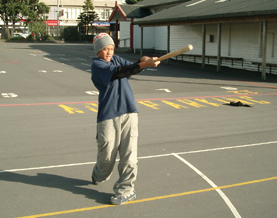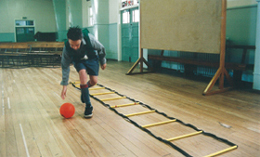| |
: 2002 Report | |
|||||
Mean scores tables health | physical
education |
|||||||
|
An additional feature
in national monitoring since 1999 has been the commitment to look directly
at the achievement of Pacific students in New Zealand primary and intermediate
schools. These students were among the samples in NEMP assessments between
1995 and 1998, but not in sufficient numbers to allow their results
to be reported separately. At the request of the Ministry of Education,
in each year since 1999 NEMP has selected special additional samples
of 120 year 4 students and 120 year 8 students, so that the achievement
of Pacific students could be assessed and reported. The augmented samples
are too small, however, to allow separate reporting on students from
different Pacific nations (such as Samoa, Tonga and Fiji).
The results for
Pacific, Mäori, and “other” students in the schools
with more than 15 percent Pacific students were then compared. Because
all of the schools chosen for these analyses have at least 15 percent
Pacific students, the results only apply to students at schools like
these. |
| YEAR
8 – HEALTH |
||||||||||||||||||||||||||||||||||||||||||||||||||||||||||||||||||||||||||||||||||||||||||||||||||||||||||||||||||||||||||||||||||||||||||||||||||||||||||||||||||||||||||||||||||||||||||||||||||||||||||||||||||||||||||||||||||||||||||||||||||||||||||||||||||||||||||||||||||||||||||||||||||||||||||||||||||||||||||||||||||||||||||||||||
| Average
(mean) marks for year 4 and year 8 students, attending schools enrolling
at least fifteen percent Pacific students, who are classified as Pacific
students, Mäori students or "other" students. |
||||||||||||||||||||||||||||||||||||||||||||||||||||||||||||||||||||||||||||||||||||||||||||||||||||||||||||||||||||||||||||||||||||||||||||||||||||||||||||||||||||||||||||||||||||||||||||||||||||||||||||||||||||||||||||||||||||||||||||||||||||||||||||||||||||||||||||||||||||||||||||||||||||||||||||||||||||||||||||||||||||||||||||||||
| Statistically
significant (p<.05) differences among the means are shown thus: significantly
lower or higher.
|
||||||||||||||||||||||||||||||||||||||||||||||||||||||||||||||||||||||||||||||||||||||||||||||||||||||||||||||||||||||||||||||||||||||||||||||||||||||||||||||||||||||||||||||||||||||||||||||||||||||||||||||||||||||||||||||||||||||||||||||||||||||||||||||||||||||||||||||||||||||||||||||||||||||||||||||||||||||||||||||||||||||||||||||||
For year 4 students, there were statistically significant differences in performance among the three groups on four of the 28 health tasks. The Pacific students scored lower than the “other” students on all four tasks. There were also statistically significant differences on two questions of the Health Survey. Pacific and Mäori student were more positive than “other” students about doing health education in school (question 1), and compared to “other” students Pacific students believed that their class more often did things to help them learn about health (question 4). |
For year 8 students, there were statistically significant differences in performance among the three groups on five of the 36 health tasks. The Pacific students scored lower than the “other” students on all five tasks, and than the Mäori students on one of the five tasks. There were no statistically significant differences on questions of the Health Survey. |
|||||||||||||||||||||||||||||||||||||||||||||||||||||||||||||||||||||||||||||||||||||||||||||||||||||||||||||||||||||||||||||||||||||||||||||||||||||||||||||||||||||||||||||||||||||||||||||||||||||||||||||||||||||||||||||||||||||||||||||||||||||||||||||||||||||||||||||||||||||||||||||||||||||||||||||||||||||||||||||||||||||||||||||||
| YEAR
8 – PHYSICAL EDUCATION |
||||||||||||||||||||||||||||||||||||||||||||||||||||||||||||||||||||||||||||||||||||||||||||||||||||||||||||||||||||||||||||||||||||||||||||||||||||||||||||||||||||||||||||||||||||||||||||||||||||||||||||||||||||||||||||||||||||||||||||||||||||||
| Average
(mean) marks for year 4 and year 8 students, attending schools enrolling
at least fifteen percent Pacific students, who are classified as Pacific
students, Mäori students or "other" students. |
||||||||||||||||||||||||||||||||||||||||||||||||||||||||||||||||||||||||||||||||||||||||||||||||||||||||||||||||||||||||||||||||||||||||||||||||||||||||||||||||||||||||||||||||||||||||||||||||||||||||||||||||||||||||||||||||||||||||||||||||||||||
| Statistically
significant (p<.05) differences among the means are shown thus: significantly
lower or higher.
|
||||||||||||||||||||||||||||||||||||||||||||||||||||||||||||||||||||||||||||||||||||||||||||||||||||||||||||||||||||||||||||||||||||||||||||||||||||||||||||||||||||||||||||||||||||||||||||||||||||||||||||||||||||||||||||||||||||||||||||||||||||||
|
|
|||||||||||||||||||||||||||||||||||||||||||||||||||||||||||||||||||||||||||||||||||||||||||||||||||||||||||||||||||||||||||||||||||||||||||||||||||||||||||||||||||||||||||||||||||||||||||||||||||||||||||||||||||||||||||||||||||||||||||||||||||||
|
For year 4 students, there was a statistically significant difference in performance among the three groups on just one of the 22 physical education tasks. The Pacific and Mäori students scored higher than the “other” students on Link Task 13. There was also a difference on one question of the Physical Education Survey, with Mäori and Pacific students believing that their teachers rated their physical education capabilities more positively (question 3).
|
For year 8 students, there were statistically significant differences in performance among the three groups on just 2 of the 23 physical education tasks. The Mäori students scored higher than the “other” students on Ti Räkau, and both the Mäori and Pacific students scored higher than the “other” students on Link Task 20. There were also statistically significant differences on six questions of the Physical Education Survey, with the Pacific students more positive than the “other” students on all six questions: how much they liked physical education in school (question 1), how good they thought they were at physical education (question 2), how highly they thought their teachers rated their physical education capabilities (question 3), how much they liked doing physical education in their own time (question 6), their wish to do more physical education in school (question 7), and their desire to keep learning physical education when they were older (question 8). | |||||||||||||||||||||||||||||||||||||||||||||||||||||||||||||||||||||||||||||||||||||||||||||||||||||||||||||||||||||||||||||||||||||||||||||||||||||||||||||||||||||||||||||||||||||||||||||||||||||||||||||||||||||||||||||||||||||||||||||||||||||
| Summary Compared to Mäori and “other” students in schools with more than 15 percent Pacific students, both year 4 and year 8 Pacific students in these schools performed less well than the “other” students on 14 percent of the health tasks, but better than the “other” students on 5 percent of the physical education tasks. In both areas and at both year levels, Pacific students performed very similarly to Mäori students in their schools. On the two surveys, the most notable feature was the high level of enthusiasm for and perceived competence in physical education displayed by year 8 Pacific students. |

